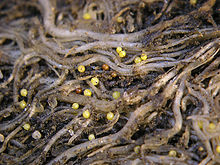Potato cyst nematode
| Potato cyst nematode (Eel worms) | |
|---|---|
 |
|
| Nematode cysts on potato roots | |
| Scientific classification | |
| Kingdom: | Animalia |
| Phylum: | Nemotoda |
| Class: | Secernentea |
| Order: | Tylenchida |
| Family: | Heteroderidae |
| Subfamily: | Heteroderinae |
| Genus: |
Globodera Skarbilovich, 1959 |
| Species | |
Potato root nematodes or potato cyst nematodes (PCN) are 1-mm long roundworms belonging to the genus Globodera, which comprises around 12 species. They live on the roots of plants of the Solanaceae family, such as potatoes and tomatoes. PCN cause growth retardation and, at very high population densities, damage to the roots and early senescence of plants. The nematode is not indigenous to Europe but originates from the Andes. Fields are free from PCN until an introduction occurs, after which the typical patches, or hotspots, occur on the farmland. These patches can become full field infestations when unchecked. Yield reductions can average up to 60% at high population densities.
The eggs hatch in the presence of Solanoeclepine A, a substance secreted by the roots of host plants. The larvae then invade the tips of the root and establish a feeding site. Both susceptible and resistant potato varieties will suffer from growth retardation at low and medium populations densities. At very high population densities mechanical damage of the root system will occur (Seinhorst, 1986). The female individuals swell up and appear as cysts on the surface of the roots, each containing up to 400 eggs. In temperate zones only one generation per year will occur. In the Mediterranean countries sometimes a second generation is reported. Cysts can then also be found on the skin of the tubers. Each year without host a certain fraction of the eggs will hatch (spontaneous hatch). The eggs can survive for up to 20 years inside these cysts.
The speed of spread of the nematodes from field to field can be reduced by cleaning equipment of possibly infested soil before changing location and by using only certified PCN-free seed tubers. If possible, ask for seed potatoes grown on fields which were declared free of the potato cyst nematode using an AMI-intensive soil sampling scheme (currently only available in The Netherlands). Pesticides can be used, but they will not get a field free of nematodes. They will increase yields and are only profitable at high population densities, when the financial profit of the extra yield will surpass the cost of the pesticide application. Crop rotation with at least 6 years between planting of a susceptible crop is an effective means to reduce nematode population densities to below damage threshold. However, the best way to manage potato cyst nematodes is the use of (partial) resistant potato varieties. During the last 10 years a number of varieties have been developed which can keep both potato cyst nematode species below damage and detection threshold, without the use of pesticides. The official recommendations and requirements for crop rotation vary between countries.
...
Wikipedia
